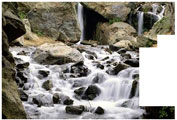Sustainable community development is defined as development that integrates ecological, social and economic decision-making. Since most Canadians are members of multiple and overlapping communities, communities are defined broadly in this research, not only by place, but also overlapping communities of practice (Lesser and Prusak 2000), professional affiliation, shared interests and networks (Citizens’ Dialogue 2003), and space, that is, virtual communities. In addition, the label “community” requires that they form a regularly interacting system of networks (Onyx, Osburn, Bullen, in press). ‘Deliberative dialogue’ is defined as deliberately designed safe-to-fail learning environments that allow diverse groups of people to engage in informed discussion with their peers and experts, to explore their implications and examine alternative social responses. ‘E-clustering’ is the development of nested sets of communities electronically that can then be scaled upward, trying to engage people functioning at all levels (Holling 2003), thereby creating novel electronic communities or “e-communities” of practice for sustainable development. E-dialogues are a means of deliberative discourse and dialogue accessible to a wider audience of engaged citizens and policy makers alike, who through shared dialogue and learning on-line form novel electronic communities.
The co-evolution of human and natural systems, and the current scale of human activities means that our survival may now depend on our ability to deliberatively re-design our communities in new ways (Dale 2001). Questions of scale, place, limits and diversity are key to this re-design, and these questions can only begin to be addressed through meta-societal dialogues or conversations for the future (Robinson, forthcoming) in individual communities—spatial or virtual. The research approach and plans to advance the work on sustainable community development will focus on these key issues in the following ways.
PLACE
Each community is located in a specific geographic, historical and ecological landscape, and as such, each possesses particular and unique socio-economic and cultural characteristics. Place is important in that it determines access to particular types of resources, not the least of which are natural resources, the backbone of the Canadian economy. Yet, it is clear that communities everywhere are facing loss of ecological integrity, in large part due to the degradation and depletion of natural capital. In addition, globalization has dramatically changed the ability of place-based communities to be ‘maitres chez nous”, and this is
and this is  especially the case in Canada which has an overwhelmingly urban population. Large urban centres in particular are facing growth and development issues such as sprawl, and a corresponding sense of loss of identity in the landscape—a ‘placelessness’ due to homogenization of both land use and landform. Indeed, all urbanizing communities are facing spatial homogeneity through fragmentation of the natural landscape and an unwillingness or inability to plan growth and development at an appropriate scale. This research will identify the current state of each community ecologically, socially and economically through extensive data gathering, linking natural and social science information through visual mapping within the community. A significant component of the ‘socio-ecological’ mapping will be qualitative community surveys that will capture some of the untold narratives and personal place-based experiences about what makes or made each particular community an intrinsically identifiable and uniquely recognizable “place” to its inhabitants.
especially the case in Canada which has an overwhelmingly urban population. Large urban centres in particular are facing growth and development issues such as sprawl, and a corresponding sense of loss of identity in the landscape—a ‘placelessness’ due to homogenization of both land use and landform. Indeed, all urbanizing communities are facing spatial homogeneity through fragmentation of the natural landscape and an unwillingness or inability to plan growth and development at an appropriate scale. This research will identify the current state of each community ecologically, socially and economically through extensive data gathering, linking natural and social science information through visual mapping within the community. A significant component of the ‘socio-ecological’ mapping will be qualitative community surveys that will capture some of the untold narratives and personal place-based experiences about what makes or made each particular community an intrinsically identifiable and uniquely recognizable “place” to its inhabitants.
Potential Research questions include: What are the critical geophysical characteristics necessary to continuing community development? What are the critical ecological foundations to be sustained? How are community demographics changing our sense of place? What constitutes a “sense of place” in globalized, urbanized communities? How is the relationship changing between communities and “nature” in the new urban condition?
SCALE
The country’s major population growth has occurred in four major urban areas: Montreal, Toronto and its surrounding area, the Edmonton-Calgary corridor, and British Columbia’s Lower Mainland. One in three Canadians now lives in one of the country’s three largest cities, and half of all Canadians live in one of the four major urban areas just mentioned. Cities are becoming larger and larger and yet evidence shows that their ecological footprint far exceeds their local carrying capacity (Wackernagel and Rees 1996). Further, an increase in development, and therefore management scale has dramatic impacts upon critical access to resources, not the least of which, is knowledge and diverse expertise. The research program will use tools such as ecological footprint analysis, and scenario modeling to reveal the underlying importance of scale issues (such as growth, development, landscape, etc) to ecological integrity, community-based sense of place, access to  intellectual capital
intellectual capital  and ultimately, sustainable community development. As well, the research will employ scale-dependent systems approaches to analysis, which will explicitly recognize the scale and context of each community under its investigation, and the implication of such scale for governance.
and ultimately, sustainable community development. As well, the research will employ scale-dependent systems approaches to analysis, which will explicitly recognize the scale and context of each community under its investigation, and the implication of such scale for governance.
Potential Research questions. Is there an optimum scale for urban and rural development? Are there different ways of structuring urban and rural settlements to enhance and compliment one another? Is there a scale at which important social and ecological constraints are reached, before the special characteristics of place are undermined and changed irretrievably? What are the ways in which scale-dependent research can be used to inform governance?
LIMITS
Expanding research activity, especially in e-learning contexts, around the meaning of limits (to growth, development, consumption, etc.) is another important component of the overall research plan. Community decisions on limits are highly pluralistic and normative, and therefore can only be decided by sharing and learning strategies in the community. These inevitably rel y on sus
y on sus tained dialogue and enhanced civic literacy around critical social and political as well as ecological questions of limits. There is no one clear, simple measure; it is entirely dependent on what a particular community values and defines as its needs. Engaging communities directly in the meaning of limits for their communities will be led through a series of dialogic forums, both electronically and face-to-face, building upon multi-stakeholder processes, e-dialogues and public forum discussions. Developing integrated community processes for resolution around deeply held paradigms, inherently value laden and conflicted issues leading to the potential for new forms of learning, has both theoretical and practical significance, particularly in the increasing multi-cultural context of Canadian communities.
tained dialogue and enhanced civic literacy around critical social and political as well as ecological questions of limits. There is no one clear, simple measure; it is entirely dependent on what a particular community values and defines as its needs. Engaging communities directly in the meaning of limits for their communities will be led through a series of dialogic forums, both electronically and face-to-face, building upon multi-stakeholder processes, e-dialogues and public forum discussions. Developing integrated community processes for resolution around deeply held paradigms, inherently value laden and conflicted issues leading to the potential for new forms of learning, has both theoretical and practical significance, particularly in the increasing multi-cultural context of Canadian communities.
Potential Research Questions. Are there critical biophysical limits for sustainable community development? Are these limits plastic or absolute? How can these limits be determined? How flexible are these limits, and are they more brittle or more plastic? Is the notion of limits culturally dependent? How does Canada’s growing ethno-cultural diversity affect the perception and articulation of limits?
DIVERSITY
Loss of ecological integrity everywhere is related to a concomitant loss of global biodiversity. New estimates indicate a reduction by 10% of the world’s forest cover over the past 10 years; nearly 50% of all fish stocks are fully exploited (Pauley 2003); and by 2025, 15% of all forest species will be extinct (World Resources Institute 2003). Human and cultural diversity is also declining; all but 200 of the modern world’s 6,000 languages are likely to be extinct or moribund by the end of the next century (Diamond 1993). Coming to understand the diversity of place —physical and non-phy
—physical and non-phy sical, diversity of space—mental, emotional and spiritual and diversity of life—human and non-human may be one of the most important social imperatives facing communities in this century. As more and more places, species and cultures become endangered, a range of moral decisions have to be made about when or whether to intervene based on considerations that will include governments’ limited financial resources. The research will identify critical elements of community diversification at multiple levels, to document these cases in ways that are meaningful to a wide variety of communities, and to disseminate this information through e-clustering and e-research/community collaborative strategies.
sical, diversity of space—mental, emotional and spiritual and diversity of life—human and non-human may be one of the most important social imperatives facing communities in this century. As more and more places, species and cultures become endangered, a range of moral decisions have to be made about when or whether to intervene based on considerations that will include governments’ limited financial resources. The research will identify critical elements of community diversification at multiple levels, to document these cases in ways that are meaningful to a wide variety of communities, and to disseminate this information through e-clustering and e-research/community collaborative strategies.
Potential research questions. What is the importance of ecological diversity for future economic choices? What are community alternatives and strategies for maintaining critical ecological, economic and social diversity?
